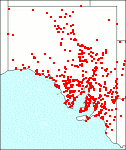Family: Asteraceae
Senecio glossanthus
Citation:
Belcher, Ann. Miss. Bot. Gard. 43:80 (1956).
Synonymy: Erechtites glossantha Sonder, Linnaea 25:524 (1853); S. brachyglossus F. Muell. ex Benth., Fl. Aust. 3:670 (1867), excluding the varieties (which appear to be based on hybrid states).
Common name: Slender) groundsel.
Description:
Erect sparsely hairy ephemeral herb, 3-25 rarely to 40 cm high; stems slender, usually branching only in the inflorescence, larger specimens sometimes also basally branching; leaves lanceolate to broad-lanceolate, 0.8-2.5 rarely to 4.6 x 0.3-1 cm, entire or irregularly toothed, sometimes ovate-lanceolate and to 6 x 2.5 cm with 1-6 distant lobes 5 times longer than broad and each denticulate or dentate, basally attenuate or clasping with toothed or lacerate auricles.
Inflorescence a corymbose panicle of 3-40 or more heads on slender peduncles 4-15 mm long; involucre narrowly campanulate, 5-6 x 3-3.5 mm; bracts 7-9 rarely 12; calyculus of 2 or 3 linear bracteoles; ray florets 4-8, ligules 0.8-1.5 x 0.5-1 mm, rarely lacking and then the corolla tube distally entire; disk florets 17-30.
Achenes subcylindrical, dimorphic, those of the ray florets c. 3 x 0.8 mm, olive-green, the width doubled by widely spreading hairs, those of the disk florets c. 2 x 0.8 mm, red-brown, densely covered either by long spreading hairs or by short appressed hairs; rarely all achenes with short hairs; pappus uniform, deciduous.
Published illustration:
Cunningham et al. (1982) Plants of western New South Wales, p. 677.
|
|
Distribution:
|
Habitat very variable but commonly requiring conditions that are only temporarily wet; ultimate size depending on the duration of favourable moisture.
S.Aust.: NW, LE, NU, GT, FR, EA, EP, NL, MU, YP, SL, KI, SE. W.Aust.; N.T.; Qld; N.S.W.; Vic.
|
Conservation status:
native
Flowering time: mainly Aug. — Sept.
|

SA Distribution Map based
on current data relating to
specimens held in the
State Herbarium of South Australia
|
Biology:
Occurs in chromosomal forms of 2n = 40 and of 2n = 80, which are visually indistinguishable in the field because of variation induced by environmental factors.
Author:
Not yet available
|

